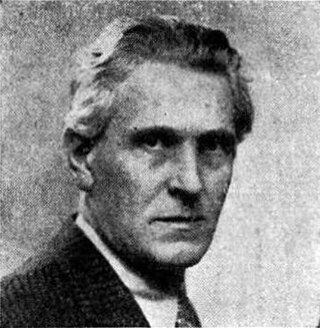
Ervin Baktay was an author noted for popularizing Indian culture in Hungary.

Three Girls, also known as Group of Young Girls, is a painting by Hungarian-Indian artist Amrita Sher-Gil. It was painted in 1935 shortly after Sher-Gil returned to India from Europe in 1934. The painting won the Gold Medal at the annual exhibition of the Bombay Art Society in 1937. The painting was part of a batch sent to Nawab Salar Jang of Hyderabad who later rejected them all.
Charles Fabri was a Hungarian art critic, writer, and Indologist. He was a former curator of the Kern Institute Library, Leiden University, curator of the Lahore Museum, Pakistan, and later lecturer at the National Museum of India, New Delhi, before lecturing at the Architecture and Art Departments of Delhi Polytechnic.

Young Girls is an oil on canvas painting created by Amrita Sher-Gil in 1932 in Paris. It was awarded a gold medal at the 1933 Paris Salon and earned Sher-Gil an associate membership of that institution. It is a national art treasure under India's Antiquities and Art Treasures Act (1972), and is held at the National Gallery of Modern Art at Jaipur House, New Delhi.

Umrao Singh Sher-Gil Majithia (1870–1954) was an Indian aristocrat, scholar of Sanskrit and philosophy, and photographer. He was known as one of the pioneers of photography in India, leaving behind over 3,000 prints, including the hundreds of family portraits and over 80 self portraits staged in a mise-en-scène style.

The untitled self portrait by Hungarian-born Indian artist Amrita Sher-Gil (1913–1941), is an oil on canvas painting completed in 1931 in Paris, and gifted to her friend Boris Taslitzky. It was created in the same year that she produced portraits of Yusuf Ali Khan, who she was engaged to, and Viktor Egan, her cousin who she later married. In 2015 it was sold for £1.7 million at auction in London.
Professional Model is an oil on canvas painting by Amrita Sher-Gil. It was created in 1933 in Paris and depicts a nude consumptive. Its vernissage took place in February 1933, the same year that her painting Young Girls earned her the title of associate member of the Paris Salon.

Sleep, also called Indu's Nude or Nude of Indira, is an oil on canvas painting by Amrita Sher-Gil, completed in 1933. It depicts a view from above of Sher-Gil's younger sister Indira, naked and lying on a white sheet at a diagonal, and with one raised arm. Just beneath her is a shawl depicting a dragon, whose body appears to flow in parallel with the flow of her hair and body curves.

Reclining Nude is an oil on canvas painting by Amrita Sher-Gil, completed in 1933 in Budapest. It depicts Sher-Gil's cousin Viola, sister of her husband Victor Egan.

Young Man with Apples, also called Boris with Apples, is an oil painting on canvas created in 1932 by Hungarian-born Indian artist Amrita Sher-Gil, when she was living in Paris.

The Hungarian-born Indian artist Amrita Sher-Gil, exhibited 33 of her paintings at her One-man Show in the ballroom at Faletti's Hotel in Lahore, British India, held from 21 to 27 November 1937. Four paintings were sold in total; The Little Girl in Blue (1934), The Story (1937), Pink Self-portrait, and The Vina Player (1937).

Hill Women is an oil on canvas painting by Hungarian-Indian artist Amrita Sher-Gil, completed after she painted Hill Men in the winter of 1935 at Simla. Depicting a girl among three young women, it was influenced by the poor surrounding Sher-Gil's home in Simla, India.

The Vina Player (1937) is an oil on canvas painting by Hungarian-Indian artist Amrita Sher-Gil. It was number five of her 33 paintings displayed at her solo exhibition in the ballroom at Faletti's Hotel in Lahore, British India, held from 21 to 27 November 1937. Sher-Gil's mother's favourite, it was initially not for sale, but then acquired by the Lahore Museum, through the encouragement of art critic Charles Fabri and the then museum's curator K. N. Sitaram.

Village Scene is an oil on canvas painting depicting Indian village life, completed in 1938 at Simla, India, by Hungarian-Indian artist Amrita Sher-Gil. In March 2006 it was sold for $1.6 million.

Brahmacharis is an oil on canvas painting by Hungarian-Indian artist Amrita Sher-Gil, completed in May 1937 at Shimla, India. It is one of her large compositions and one of her South Indian trilogy, along with Bride's Toilet and South Indian Villagers going to Market. In 1937 it was displayed at her Lahore exhibition for a price of ₹1,500.

Child Wife, also known as Child Bride (1936), is an oil on canvas painting by Hungarian-Indian artist Amrita Sher-Gil. It measures 53 × 76 cm, and belongs to the Saraya private collection.

The Last Unfinished Painting, originally titled On the Roof, is Amrita Sher-Gil's last oil on canvas painting, created from the window of her apartment in Lahore, India, shortly before her death in December 1941. Her intention was to paint what she could see from her terrace: the milkmen's buffaloes that lived near her house. A detailed account of the painting is given in Vivan Sundaram's last unwritten letter, which he dated 1 December 1941. In it is described a mysterious black object that appears in the bottom right corner, though it was erased in a restoration after 1944.

South Indian Villagers going to Market is an oil on canvas painting by Hungarian-Indian artist Amrita Sher-Gil. It was painted at Sher-Gil's home, The Holme, Shimla, India, around October- November 1937, along with the two smaller compositions, The Story Teller and Siesta. It is one of her large compositions and one of her South Indian trilogy, along with Bride's Toilet and Brahmacharis. In 1937 it was displayed at her Lahore exhibition for a price of ₹1,500.
Woman on Charpoy is an oil on canvas painting depicting an Indian woman in red, lying on a charpoy with one leg bent. It was completed in 1940 by Hungarian-Indian artist Amrita Sher-Gil.
















